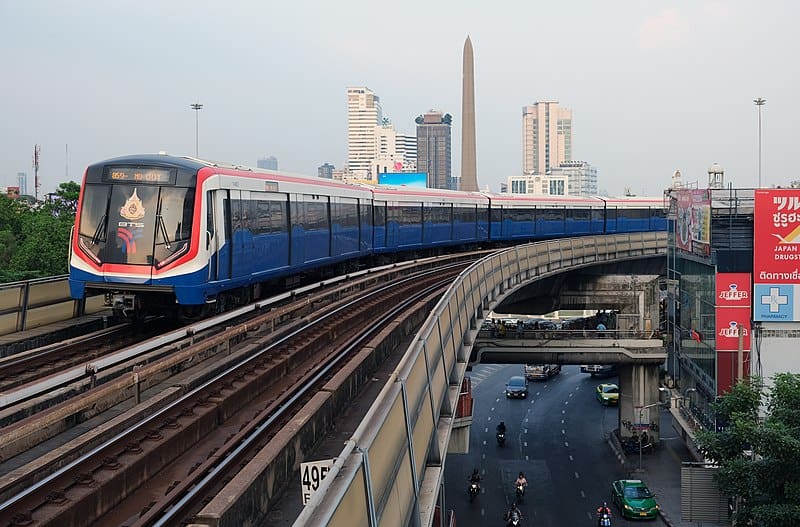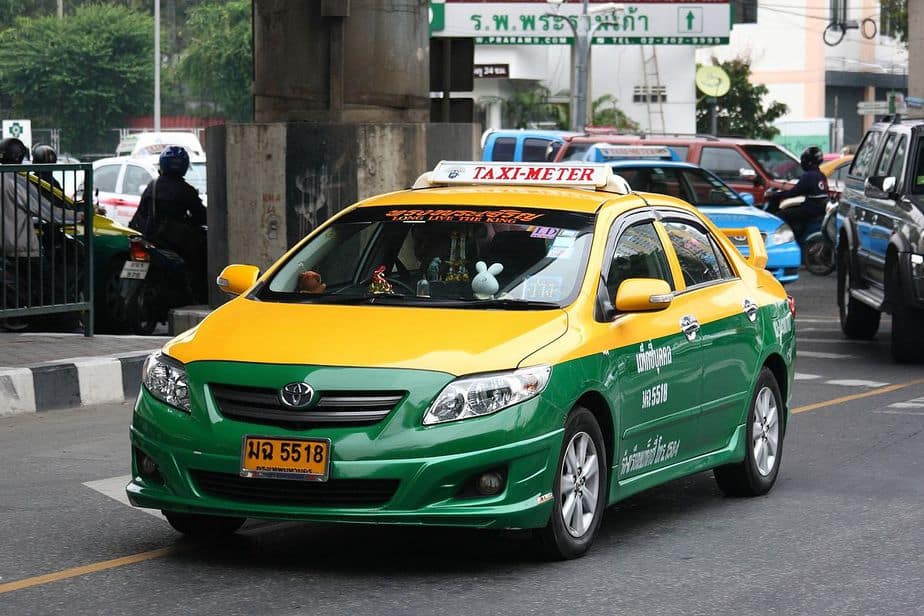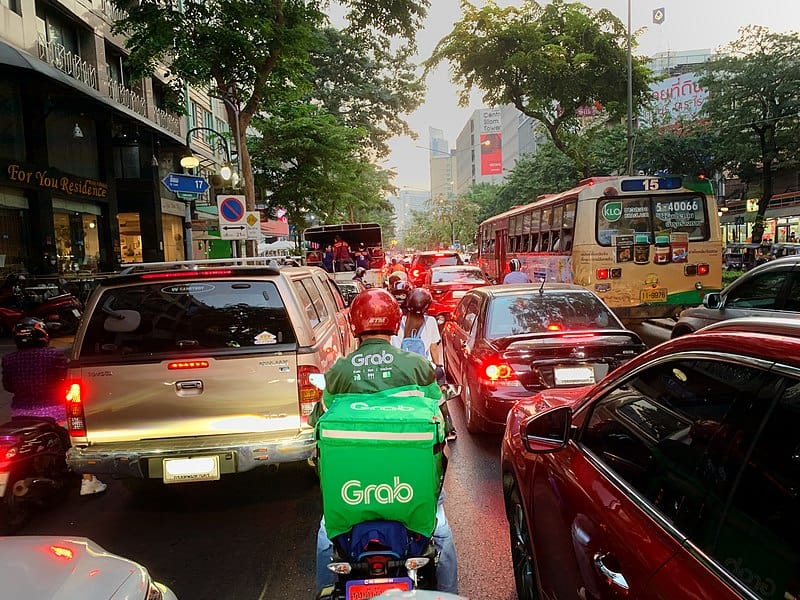A Brief Guide to Getting Around Bangkok
By Mark Philip
Bangkok is a constantly-evolving capital city that looks and feels different every time you visit the place.
It’s a sprawling, ill-planned city with one of the most obvious traffic (and people) congestion issues you are ever likely to encounter. Thankfully though, the infrastructure and the main modern transportation systems running through the urban highways are consistently undergoing development, improvement, and expansion.
There have always been seemingly huge gaps in the areas covered by the 2 main city-centre rail transportation systems — both on different levels to the ground entirely — with both only seeming to stretch so far and rarely meeting in the middle.
These ‘gaps’ have for the most part been filled by unreliable, under-funded (and often unsafe) bus and van services, along with taxis and motorbikes (both of which have often proved unreliable and unsafe to various degrees). All of this adds fuel to the cause of those drivers who feel they are justified by being on an already overcrowded road.
And yet if logic dictates that all operations within Bangkok gradually turn more and more towards an interconnected, mass system of transportation that is smooth, efficient, real-time, classless, and encompasses trains both above and below ground-level, operating according to the same instructions and guidelines, while providing informative and friendly customer service, in a variety of languages at all times…then there aren’t any visible signs that it has actually happened just yet!
The good news is though, since their inception more than a decade ago, there have been plenty of add-ons and adjustments to both of the ever-growing BTS Skytrain and MRT Subway systems. The extensions to both transportation infrastructures still continue, with ongoing future development projects planned, meaning farther and wider access across Bangkok in all directions, although it is worth noting at this point that the two systems are operated almost independently of each other.
The Skytrain and Metro systems can sometimes be a challenge to negotiate at first, but they remain undoubtedly the fastest way to get across all points of the city, in all directions, as far as the current routes of the two systems combined allows.
We recommend that any ‘gaps in your maps’ (i.e. areas you go to not serviced closely enough for any reason by either of the two lines) be filled-in using our second main option, the Grab App.
Which is all great news for ardent local commuters, as well as Bangkok-loving visitors who would rather zip across the skies on the BTS or slide through the subways on the MRT than negotiate the choc-a-bloc, stuck on the road in a traffic jam scenario, in the cab of a taxi driver who has no actual clue where he is going, or sit it out in a fume-filled, rickety old bus and witness the tantrums of a double-shift-working bus driver with no clear plan in terms of a lane.
We’ve all been there and done that, without even touching on almost having been half-killed on numerous occasions by the heedless, often wreckless motorcycle taxi bike riders that admittedly might’ve seemed like fun on the first couple of visits to the country, but are now looking more like dangerous and ill-conceived modes of transportation on every visit to Bangkok.
Taxis in Bangkok
Anyone who has been to the Thai capital before and tried to get around under their own steam may have soon found that can be innumerable variables involved, especially in terms of taking taxi cabs.
Traditionally, most tourists in Bangkok have never generally given a second thought to going the taxi route – many mistakenly so, usually under the false impression that: A. Bangkok taxi drivers speak English. B. Bangkok taxi drivers will accept you as a fare. C. Bangkok taxi drivers know where your destination is. D. Bangkok taxi drivers all use meters, etc., etc.
Thankfully though, there are now undoubtedly more ways than ever before from which to approach the situation.
Just as supply always follows demand, Uber and Grab (now only Grab) introduced the concept of a safer, more guaranteed (to accept the fare, to find the destination), more comfortable, private transport experience, which was pretty much what everyone had been waiting for in Bangkok. More on that later.
Buses
The buses in Bangkok are slowly showing improvement, in terms of their road-worthiness and route –planning both. Now with more modern-looking, air-conditioned buses appearing on the roads every year, several fixed-route runs such as those run by the BRT which shuttle as connecters to some BTS or BEM stations in selected regions of the city. There are even bus timetables appearing at Bangkok bus stops, a concept unheard of until recently, and there do seem to be considerably smaller queues at the stops.
Other options
However, in this brief guide if we may be so bold we would hasten to steer you away from the idea of taking a bus in Bangkok, leaving that instead for the more adventurous visitor to the capital with time to spare as we focus here on the fastest and most efficient ways to get around Bangkok without encountering too many headaches.
So please allow us to run you few a few of the basic ins-and-outs when it comes to getting the best out of your time in everyone’s favourite Thai capital, and hopefully you’ll avoid a few upsets after you’ve read our brief guide to getting around in Bangkok!
And as this is a Brief Guide we have in fact actually narrowed things down to just a couple of options. If you are really serious about getting down to the nitty gritty and knowing how to get from A to B without encountering too many of the endless variables that could easily become time-consuming, then forget regular taxis, forget motorcycles and forget buses.
We are going to narrow this down in fact to two methods of transportation and one App – we reckon that’s all you’ll need in terms of narrowing it down to the nuts and bolts of getting around in Bangkok. Trains, Private Cars, and Grab!
Trains
In this category we have 3 divisions of train running through the city to consider – the sky train, the subway train, and the regular train – although it is the two former options that take up most of what we have to say here, as the last option is outmoded and outdated by the recommendation of the locals, and thus serves only the die-hards with no real other option.
The Skytrain system (BTS) and the underground system (MRT) are both the most-used forms of transportation on a daily basis by the majority of Bangkok-dwellers from in and around the city. And this means they are likely to be packed—literally – at least during certain times of the day and at particular stations.
Avoiding rush hours
As you’d expect, Bangkok suffers from the same kind of rush hour time zones as every other major city—sometimes to the extreme – and either end of it may be extended by a couple of hours on regular occasion.
As a general rule, try and avoid this by allowing at least two hours before or after your designated stop if you want more chance of a bit of ‘leg room’ in order to make sure you get where you need to be when you want to be, and avoid any of the major stations for embarking or disembarking close to those times.
The major stations are generally the city-centre stops and particularly the interchange ones which connect to another system, namely Sukhumvit (Asok), Siam, and Silom, and any of the next few stations along in either direction.
Travel Cards
There remains some uncertainty among the general population as to which of the transport links are privately-owned and which ones are Government-run operations. The main thing is though, by no means are they all operated by the same company or system, and there is no ‘central nerve’ of transport operations as such.
That’s where the fun begins: you can buy discount travel cards for both the underground and skytrain systems (be prepared to show a passport). The thing is you’ll need different ones for each of them.
BTS Rabbit Cards: They definitely are worth buying if you plan on being around the city for more than a few days, and using Rabbit Cards in Bangkok can provide significantly cheaper options than paying trip by trip, along with queuing at counters and ticket machines; having the right change, etc., etc.
Check out how to buy a Rabbit Card
BTS Rabbit Cards for Young, Elderly and Standard ticket bearers are available, with further discounts available in categories, and a number of other options including digital, cashless payment for all.
The cards can be topped up with cash or trips. The more trips you buy, the cheaper the trips actually become, sometimes by more than half if using daily.
The ‘Metro System’ as it is sometimes referred to, or more specifically the BEM (a term encompassing Bangkok Expressway and Metro, which covers the underground system) also has its own top-up cards in operation which work in a very similar way to the Rabbit Cards.
The MRT has different options of fare as well as its own travel card.
TIPS Just beware that the number of trips or card amount will have an expiry date on it (as do telephone and internet credit etc.in Thailand) — this should be noted from the receipt and the slip retained, and that there will be some kind of fee to pay and ID required in order to get these cards.
Be prepared to lose all sight of the 200+ ‘deposit’ that is asked for along with some form of ID and feel free to clarify its exact significance if you will. Those who’ve been around long enough know the ‘card fee’ is less than unlikely to be refunded (there generally are no refunds in Thailand), even when the card is returned, or simply stops functioning.
Grab
The concept of quality private transportation came about in direct level response to the ongoing problem of taxi drivers’ attitudes, and was initiated and abetted first by Uber, then Grab. For whatever reasons, Uber departed from operating in Southeast Asia a couple of years back, and sold out to their former main rivals — Grab.
Now it is almost impossible to go anywhere in Bangkok without constantly laying eyes on the green Grab emblem. This is because the brand has also long since branched out into other areas such as food shopping and delivery, as well as reinforcing its name as the leader amid rising competition in the field of providing a guaranteed, dedicated, quality private transportation service.
So it is worth downloading the Grab App before you even get into Thailand if you are planning on using it. Once you’ve done that it will be possible to use the smartphone app to get a private car from the airport to your hotel if you don’t have one booked.
They offer fixed prices for cars and taxis, which are given before you book through the Grab app. The reassuring thing about using these services is that the drivers are accountable, with their identity and number plate revealed when you are given the booking acceptance notification, along with an estimated time of arrival which is usually not far out and is updated real-time, with a connection to the driver if necessary (they will sometimes call you when they arrive or if they are delayed)
The obvious plus is that all of the rides are tracked by GPS, so it’s quite easy to see if your driver knows how to use one or not.
Ordering a driver and making a booking couldn’t be simpler, as you can either use your current location or mark it on a map. Your destination and generates a price. There will be a few options for Grab Car, Grab taxi or a Grab bike
The selling point of Grab Cars though, is that generally they are driven with a little more finesse and professionalism than say, your average Bangkok Taxi. So if you would rather avoid public-style transportation systems during your time in Bangkok and you’ve already had that ‘Bangkok taxi experience’ – Grab Car might be your new best friend.
Planning a trip to Paris ? Get ready !
These are Amazon’s best-selling travel products that you may need for coming to Paris.
Bookstore
- The best travel book : Rick Steves – Paris 2023 – Learn more here
- Fodor’s Paris 2024 – Learn more here
Travel Gear
- Venture Pal Lightweight Backpack – Learn more here
- Samsonite Winfield 2 28″ Luggage – Learn more here
- Swig Savvy’s Stainless Steel Insulated Water Bottle – Learn more here
Check Amazon’s best-seller list for the most popular travel accessories. We sometimes read this list just to find out what new travel products people are buying.

















